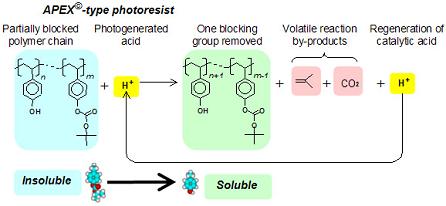Post-Exposure Bake |
| The post exposure bake (PEB) serves multiple purposes in photoresist processing. First, the elevated temperature of the bake drives diffusion of the photoproducts. A small amount of diffusion can be useful in minimizing the effects of standing waves – periodic variations in exposure dose throughout the depth of the film that result from interference of incident and reflected radiation. The other main purpose of the PEB is to drive the acid-catalyzed reaction that alters the solubility of the polymer in many chemically amplified resists. Chemical amplification is very important because it allows a single photoproduct to cause many solubility-switching reactions, thus increasing the sensitivity of these photoresist systems. Some amount of acid transport is necessary in that it allows a single acid to move to many reactive polymer sites. However, acid transport from nominally exposed to unexposed regions can complicate control of resist feature dimensions. Acid transport through these reactive systems is mechanistically complex: measurements have shown that there is a very large difference in acid mobility between the starting material (reactive towards acid) and the product material (which is no longer reactive). More details on these experiments are provided elsewhere on this website. |
 |
| Our simulation of the PEB is essentially identical in structure to the PAB simulation. Both steps involve the same elevated temperature processing. In both processes, transport and desorption of small molecules are important, as are polymer motions and film shrinkage. However, the main mechanism of the PAB in chemically amplified resists is the chemical reaction that alters the solubility of the polymer. This reaction occurs slowly in the absence of acid, but the reaction rate is greatly increased when acid is present. The inputs to this simulation module include the solubility parameters of the components, which are used to calculate the interaction energy between lattice components. The activation energies of the various reactions are also input, and are used to calculate the probability of occurrence of a given reaction at the simulation temperature. |
| Next: Development Module |
